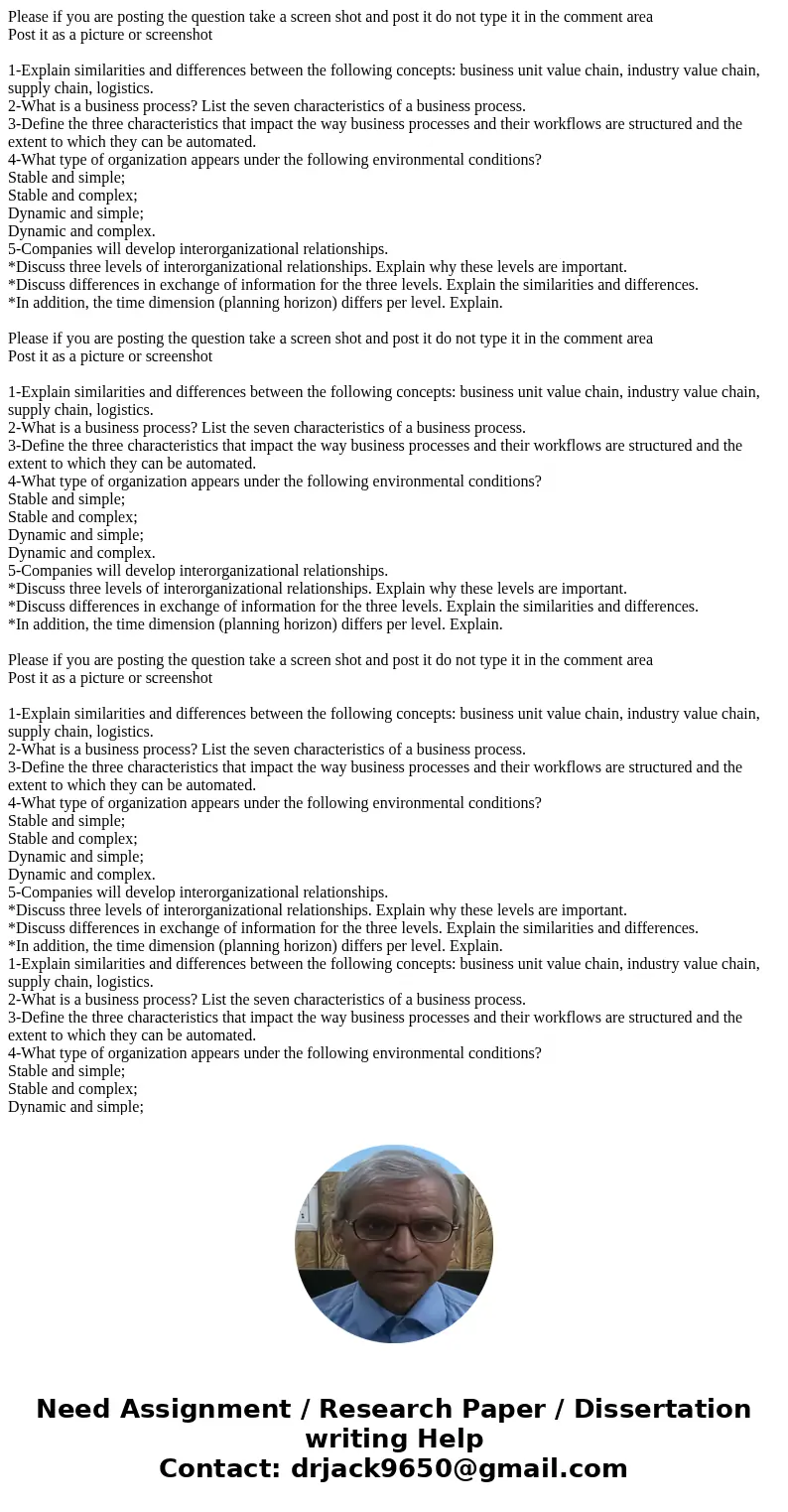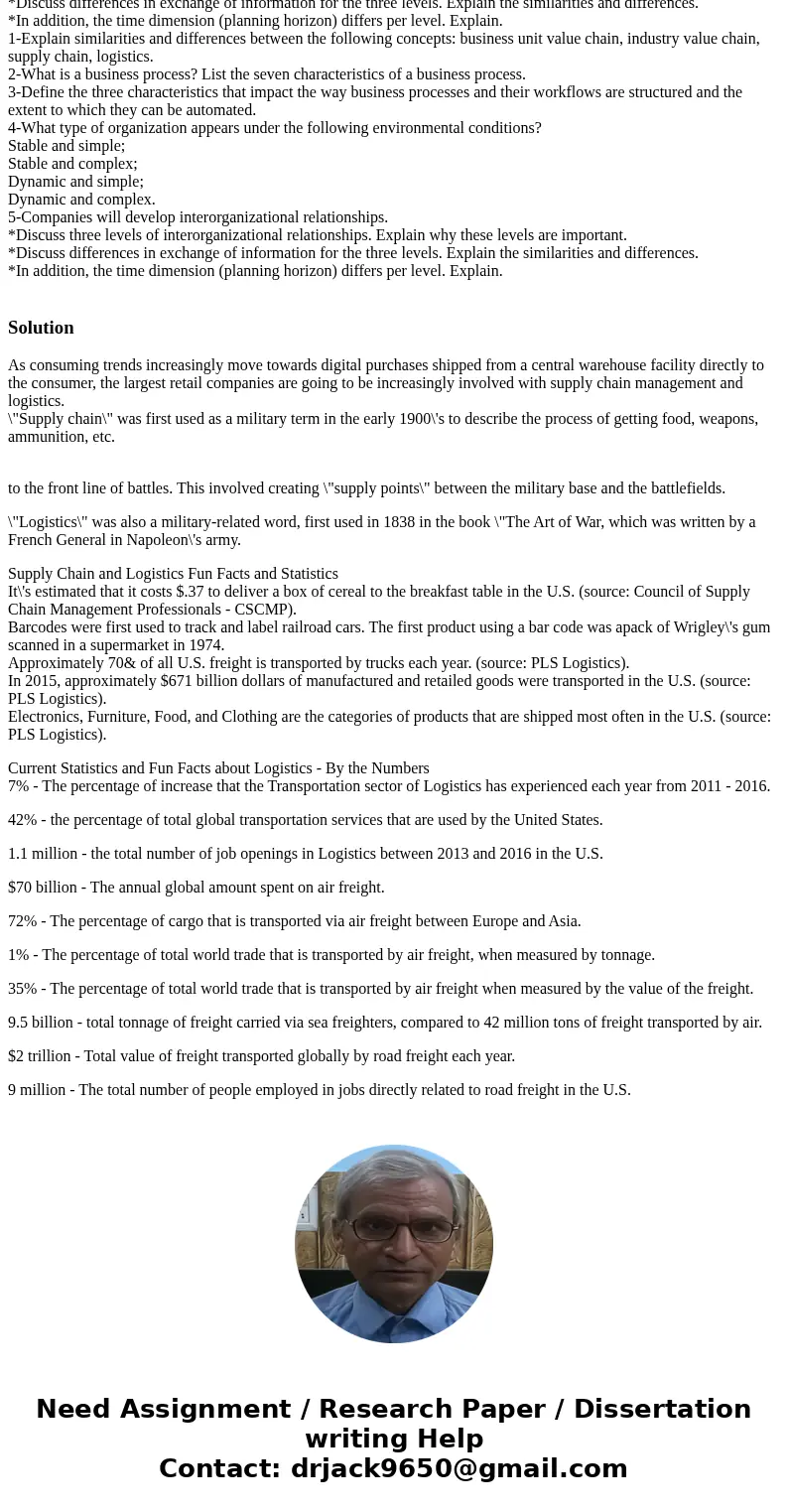Please if you are posting the question take a screen shot and post it do not type it in the comment area
Post it as a picture or screenshot
1-Explain similarities and differences between the following concepts: business unit value chain, industry value chain, supply chain, logistics.
2-What is a business process? List the seven characteristics of a business process.
3-Define the three characteristics that impact the way business processes and their workflows are structured and the extent to which they can be automated.
4-What type of organization appears under the following environmental conditions?
Stable and simple;
Stable and complex;
Dynamic and simple;
Dynamic and complex.
5-Companies will develop interorganizational relationships.
*Discuss three levels of interorganizational relationships. Explain why these levels are important.
*Discuss differences in exchange of information for the three levels. Explain the similarities and differences.
*In addition, the time dimension (planning horizon) differs per level. Explain.
Please if you are posting the question take a screen shot and post it do not type it in the comment area
Post it as a picture or screenshot
1-Explain similarities and differences between the following concepts: business unit value chain, industry value chain, supply chain, logistics.
2-What is a business process? List the seven characteristics of a business process.
3-Define the three characteristics that impact the way business processes and their workflows are structured and the extent to which they can be automated.
4-What type of organization appears under the following environmental conditions?
Stable and simple;
Stable and complex;
Dynamic and simple;
Dynamic and complex.
5-Companies will develop interorganizational relationships.
*Discuss three levels of interorganizational relationships. Explain why these levels are important.
*Discuss differences in exchange of information for the three levels. Explain the similarities and differences.
*In addition, the time dimension (planning horizon) differs per level. Explain.
Please if you are posting the question take a screen shot and post it do not type it in the comment area
Post it as a picture or screenshot
1-Explain similarities and differences between the following concepts: business unit value chain, industry value chain, supply chain, logistics.
2-What is a business process? List the seven characteristics of a business process.
3-Define the three characteristics that impact the way business processes and their workflows are structured and the extent to which they can be automated.
4-What type of organization appears under the following environmental conditions?
Stable and simple;
Stable and complex;
Dynamic and simple;
Dynamic and complex.
5-Companies will develop interorganizational relationships.
*Discuss three levels of interorganizational relationships. Explain why these levels are important.
*Discuss differences in exchange of information for the three levels. Explain the similarities and differences.
*In addition, the time dimension (planning horizon) differs per level. Explain.
1-Explain similarities and differences between the following concepts: business unit value chain, industry value chain, supply chain, logistics.
2-What is a business process? List the seven characteristics of a business process.
3-Define the three characteristics that impact the way business processes and their workflows are structured and the extent to which they can be automated.
4-What type of organization appears under the following environmental conditions?
Stable and simple;
Stable and complex;
Dynamic and simple;
Dynamic and complex.
5-Companies will develop interorganizational relationships.
*Discuss three levels of interorganizational relationships. Explain why these levels are important.
*Discuss differences in exchange of information for the three levels. Explain the similarities and differences.
*In addition, the time dimension (planning horizon) differs per level. Explain.
As consuming trends increasingly move towards digital purchases shipped from a central warehouse facility directly to the consumer, the largest retail companies are going to be increasingly involved with supply chain management and logistics.
\"Supply chain\" was first used as a military term in the early 1900\'s to describe the process of getting food, weapons, ammunition, etc.
to the front line of battles. This involved creating \"supply points\" between the military base and the battlefields.
\"Logistics\" was also a military-related word, first used in 1838 in the book \"The Art of War, which was written by a French General in Napoleon\'s army.
Supply Chain and Logistics Fun Facts and Statistics
It\'s estimated that it costs $.37 to deliver a box of cereal to the breakfast table in the U.S. (source: Council of Supply Chain Management Professionals - CSCMP).
Barcodes were first used to track and label railroad cars. The first product using a bar code was apack of Wrigley\'s gum scanned in a supermarket in 1974.
Approximately 70& of all U.S. freight is transported by trucks each year. (source: PLS Logistics).
In 2015, approximately $671 billion dollars of manufactured and retailed goods were transported in the U.S. (source: PLS Logistics).
Electronics, Furniture, Food, and Clothing are the categories of products that are shipped most often in the U.S. (source: PLS Logistics).
Current Statistics and Fun Facts about Logistics - By the Numbers
7% - The percentage of increase that the Transportation sector of Logistics has experienced each year from 2011 - 2016.
42% - the percentage of total global transportation services that are used by the United States.
1.1 million - the total number of job openings in Logistics between 2013 and 2016 in the U.S.
$70 billion - The annual global amount spent on air freight.
72% - The percentage of cargo that is transported via air freight between Europe and Asia.
1% - The percentage of total world trade that is transported by air freight, when measured by tonnage.
35% - The percentage of total world trade that is transported by air freight when measured by the value of the freight.
9.5 billion - total tonnage of freight carried via sea freighters, compared to 42 million tons of freight transported by air.
$2 trillion - Total value of freight transported globally by road freight each year.
9 million - The total number of people employed in jobs directly related to road freight in the U.S.


 Homework Sourse
Homework Sourse